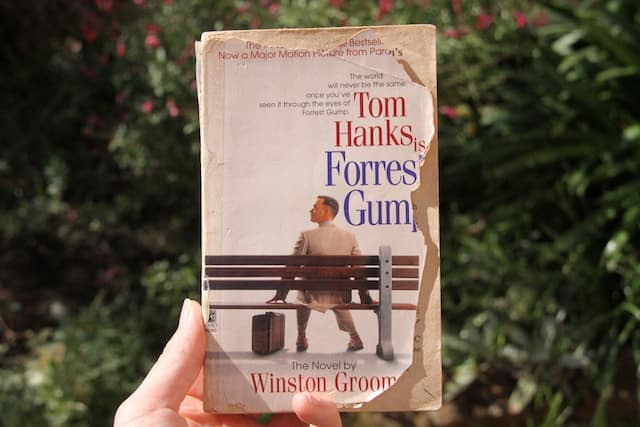How do we experience time? Is it a straight line? Does it move back and forth?
Non-linear storytelling experiments with our perception of time and how events can inform our experiences. It’s an infinitely creative way of engaging audiences in film, literature and other artistic mediums, which makes it increasingly popular with creatives.
In this article, we will discover why that is, how we define non-linear storytelling, and how you can implement it into your own work.
Let’s get started!
Definition of Non-Linear Storytelling
In short, non-linear storytelling is a narrative technique in which story events are structured in nonchronological order. We jump around the timeline of a story, going from the past to the present, and potentially back to the future (movie pun unintended!).
Unlike linear storytelling, where events are told in chronological order, non-linear storytelling, as explained by Celia Pearce, “…is defined as any body of content that is structured such that its final delivery is variable. Each time it is seen or heard, it can be presented in a different order, based on input from the user…” (pg. 100, 1994)

Compared to linear storytelling, non-linear storytelling allows the narrator to use various techniques to cut between different events. From flash-forwards, to flashbacks, dream sequences, to foreshadowing, non-linear storytelling has the ability to truly mimic the human memory and how we can recall events in our minds in variable orders.
Examples of Non-Linear Storytelling in Film
So, let’s take a look of non-linear storytelling in action. Beginning with film, here are some examples of non-linear storytelling in some of the most famous movies on the planet.
Pulp Fiction
Tarantino employs three timelines in Pulp Fiction and introduces the characters three times from the perspective of each timeline. As an audience, we see the point of view of all three sets of characters: the same moment in time from three perspectives.
This technique keeps the audience on its toes, searching every scene for relevant information and trying to decipher what will be key in the overall plot development. In short, the non-linear storytelling Tarantino uses hooks the audience and creates organic tension. The audience senses something major will happen, but how and when is a mystery through the various presented points of view.
Memento
Christopher Nolan’s Momento uses non-linear structure to accurately portray the protagonist, Leonard’s fractured memory. Like Tarantino, this is Nolan hooking the audience and thrusting them into the depths of Leonard’s experience. In a sense, they become the protagonist.
Citizen Kane
Similar to Nolan’s Momento, Citizen Kane also seems to recall a fractured memory of someone who can only remember snippets of a story. This supports Orsen Welles’ character, Kane’s portrayal as an enigma. We also see a few perspectives on Kane from other characters. The journalist’s view is the most engaging for an audience as they try to piece Kane’s story together.
Forrest Gump
Narrated by Forrest Gump himself, the movie is portrayed in third-person. With Forrest, we navigate the relationships in his life and how he uses them to inform the future. In his instance, without knowing what Forrest experienced as a child, we cannot understand how he develops.
He faces obstacles in the form of other characters, such as Jenny, Bubba, and Lieutenant Dan. The audience grows up with Forrest, and it’s through this experience that we see him face these obstacles and how he interacts with them.

Examples of Non-Linear Storytelling in Literature
Literature has also seen its fair share of non-linear story telling. Let’s take a look at some of the most effective examples.
The Sound and The Fury by William Faulkner
The story is told through the voice of Benjy, who has a mental disability. It is hard for the reader to pinpoint where in time Benjy is at any given point in the book. However, this serves as an effective tool to symbolize Benjy’s mind. He recalls events with a child’s naivety and memory, with events all over the place.
Slaughterhouse-Five by Kurt Vonnegut
With blurred lines between fantasy and reality, Slaughterhouse-Five uses jumps in time to foreshadow a temporal distortion later in the book. It serves as a pre-warning and an effective hook to readers that things won’t unfold in the way they expect.
Story of Your Life by Ted Chiang
Chiang uses non-linear storytelling to comment on psychology and physics, and how there are other ways we can view the universe and our lives within it. It’s an observation of holistic views and how events should unfold and inform one another.

The Time Traveler’s Wife by Audrey Niffenegger
Non-linear storytelling in this novel is a vehicle to show character Henry’s disorder, which allows him to time travel. Yet, it also has a deeper purpose, whereby it explores the consequences of this time travel and how it affects the relationship he has with his wife Clare, especially when he meets his future self and sees what becomes of him.
Benefits of Non-Linear Storytelling
As we’ve seen in the examples above, non-linear storytelling has been a huge success for many prolific writers. But why should you consider utilizing it in your own work, whether it’s a screenplay, short story, or novel?
Character Development
By jumping around a character’s timeline, an audience learns more about them. Their past informs their present, and the future shows their progression from that. It allows an audience to understand the characters at a much deeper level, and to connect with their decisions.
Humans are intrinsically complicated, and so non-linear storytelling is a fantastic technique in crafting relatable and unique characters.
TV series, Mad Men, is a prime example of using non-linear storytelling to enhance depth of character. It isn’t the plot, but the characters who draw the audience in, with snippets of their past lives leaving breadcrumbs of clues to their intentions and motivations.
Learn more about character development here!

Emotional Impact
Cutting between different time frames allows an audience to access the core of an emotion and relate to it on an immediate level. It makes the transition from an audience sympathizing to empathizing!
For example, in the movie Eternal Sunshine of the Spotless Mind, an audience empathizes with the protagonist, Joel’s heartache, as he recalls himself trying to resolve a breakup with his ex, Clementine. Instead of just relaying the story to his friends, we jump back and time and see the event unfold.
Stimulates Curiosity
This is perhaps the key way non-linear storytelling is a great way to make your plot more dynamic. You want your audience to be curious, to ask questions, and to want to keep reading or watching! Teasing them with details from the past, present, and future, and giving them a puzzle to solve, can make for a very satisfying story.
TV series Breaking Bad does this brilliantly, especially in the pilot. The story starts partway through the action and then jumps forwards, only returning to the first scene at the end of the episode to finally quench the audience’s thirst to know what happens.
Tips for Writing Non-Linear Stories
Structure
Non-linear stories must begin with a plan. Start by writing all your events chronologically, so you know which event sits where. Ensure you’ve pinned the main beats of your story down, and then play around with the order. Remember, it’s no use putting them in any order; there must be a reason you’re using a non-linear structure.

Create Well-Rounded Characters
When writing non-linear stories, it’s crucial to develop well-rounded characters. The audience will encounter characters at various points in their lives, so ensure that their motivations and personality traits are clear and consistent throughout the story.
Use Chronological Markers
To make your non-linear narrative easier to follow, consider adding dates, timestamps, or other such cues to indicate when there’s a time change.
Establish a Running Theme
Even if your story is non-linear, it is still crucial that you have a clear theme threaded throughout that connects plot points together. Your audience should be able to identify this.
Edit Carefully
Non-linear stories are more prone to plot holes and inconsistencies due to their nature. Ensure when rewriting, you check and double check the order of events, character development and theme consistency. Yes, your story is non-linear, but it must also be coherent and understandable.

Conclusion
So, there you have it: the wonders of non-linear storytelling and how it can enhance our understanding of stories and our perception of the world around us.
When used well, it can showcase authentic and well-rounded characters, draw out true empathy in an audience, and stimulate curiosity.
If you’re going to try your hand at implementing it into your next story, check out Celtx for all our planning tools to help you along the way. There’s no reason why you can’t experiment with it!

Citations
Pearce, C., 1994. The ins & outs of non-linear storytelling. ACM SIGGRAPH Computer Graphics, 28(2), pp.100-101.
